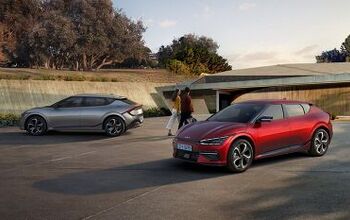Denmark EV Incentive: $40k and a Parking Spot
Along with Israel, Denmark is one of the first countries to sign on to Project Better Place’s attempt to establish a viable electric car infrastructure. And as with all early adopters, Denmark is paying a pretty price for the experiment. The country is spending $100m on infrastructure, including charging points and battery-swap stations. Moreover, Better Place’s partner, public utility Dong Energy, is trying to run the new EV infrastructure entirely on wind power, which is already the source of 20 percent of Denmark’s energy. “We’re the perfect match for a windmill-based utility,” Better Place founder and CEO Shai Agassi tells the NY Times. “If you have a bunch of batteries waiting to be charged, it’s like having a lot of buckets waiting for rain.” Despite the close government involvement in the project, Danes are still wary of making a wholesale switch to EVs, prompting the government to offer $40,000 in consumer incentives for electric vehicles, as well as free parking in downtown Copenhagen. Though there’s plenty of skepticism in Denmark about the plan, that incentive is expected to make a huge difference.
After all, buying a car in Denmark isn’t the same as buying a car in the US. The NYT explains:
The country imposes a punitive tax of about 200 percent on new cars, so a vehicle that would cost $20,000 in the United States costs $60,000 here. For a quarter-century, electric cars have been exempt from that tax. But the models on the market were so limited in their capabilities that only 497 of them are registered in the entire country.
And though the incentive combined with Better Place’s Renault/Nissan EVs might make a difference, Danes are still worried about betting the farm on a single vehicle supplier. With millions set to be spent on Better Place’s battery swap stations (under BP’s scheme, you buy a car but lease a battery, a system based on the cell phone contract model), many worry that the stations won’t be able to supply batteries to competitor EVs. “I’m skeptical about the infrastructure,” says Klaus Bondam, Copenhagen’s mayor for technical and environmental administration. “It won’t work unless it’s standard on every electric vehicle produced.”
The questions point to an underlying problem with Better Place’s strategy. Though battery leasing and swap stations theoretically eliminate range anxiety (since batteries could be swapped in less time than it takes to fill a tank with gas), the BP-specific infrastructure forces competitors wanting access to the Israeli and Danish EV markets to standardize to BP’s specifications. Though standardization of a plug-in infrastructure is clearly a major goal for all EV supporters, the terms of that standardization should not be set by a for-profit, public-private enterprise. The Society for Automotive Engineers or some other cross-industry organization should take the lead in establishing international EV standards, and should do so in such a way that doesn’t favor any one manufacturer. Otherwise, Better Place’s attempt to leap ahead in establishing its own infrastructure will end up dictating the terms of engagement for everyone else. Especially when it has such generous governmental support.
More by Edward Niedermeyer
Latest Car Reviews
Read moreLatest Product Reviews
Read moreRecent Comments
- 28-Cars-Later Mazda despite attractive styling has resale issues - 'Yota is always the answer.
- 28-Cars-Later Try again.
- Doc423 It's a flat turn, not banked, which makes it more difficult to negotiate, especially if you're travelling a little too fast.
- Jeff “So, the majority of our products are either ICE vehicles or intended to utilize those multi-energy platforms that we have. This is a great opportunity for us, compared to our peers, having the multi-energy platforms for all of our products in development and having the agility to move between them,” she said. From what is stated about the next generation Charger it will be released as a 2 door EV and then as a 4 door with the Hurricane turbo straight 6. I assume both the 2 door and 4 door is on the same platform.
- Brendan Duddy soon we'll see lawyers advertising big payout$ after getting injured by a 'rogue' vehicle

































Comments
Join the conversation
Not unknown for one company to make a product that everybody had to follow to gain markets. IBM pc's and Microsoft spring to mind. One company making a specific type of product, be first in the market place and saturate, so that every other competitor/pruducer had to emulate, licence or plain copy to remain in the market, or, go down a different path and be forever stuck with a small slice or at best a niche following.
"Though standardization of a plug-in infrastructure is clearly a major goal for all EV supporters, the terms of that standardization should not be set by a for-profit, public-private enterprise." I don't see a problem there, so long as it is an open standard. While it would be nice to wait for a governement commitee to design an alternative, do you really think it'll be a whole lot better?